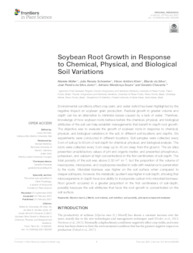Soybean root growth in response to chemical, physical, and biological soil variations.
Soybean root growth in response to chemical, physical, and biological soil variations.
Autoria: MÜLLER, M.; SCHNEIDER, J. R.; KLEIN, V. A.; SILVA, E. da; SILVA JUNIOR, J. P. da; SOUZA, A. M.; CHAVARRIA, G.
Resumo: Environmental conditions affect crop yield, and water deficit has been highlighted by the negative impact on soybean grain production. Radicial growth in greater volume and depth can be an alternative to minimize losses caused by a lack of water. Therefore, knowledge of how soybean roots behave before the chemical, physical, and biological attributes of the soil can help establish managements that benefit in-depth root growth. The objective was to evaluate the growth of soybean roots in response to chemical, physical, and biological variations in the soil, in different soil locations and depths. Six experiments were conducted in different locations. Soil samples were collected every 5 cm of soil up to 60 cm of soil depth for chemical, physical, and biological analysis. The roots were collected every 5 cm deep up to 45 cm deep from the ground. The six sites presented unsatisfactory values of pH and organic matter, and resented phosphorus, potassium, and calcium at high concentrations in the first centimeters of soil depth. The total porosity of the soil was above 0.50 m3 m−3 , but the proportion of the volume of macropores, micropores, and cryptopores resulted in soils with resistance to penetration to the roots. Microbial biomass was higher on the soil surface when compared to deeper soil layers, however, the metabolic quotient was higher in soil depth, showing that microorganisms in depth have low ability to incorporate carbon into microbial biomass. Root growth occurred in a greater proportion in the first centimeters of soil-depth, possibly because the soil attributes that favor the root growth is concentrated on the soil surface.
Ano de publicação: 2021
Tipo de publicação: Artigo de periódico
Unidade: Embrapa Trigo
Palavras-chave: Glycine max Merril, Principal component analyses, Root volume, Soil nutrition, Soil porosity
Observações
1 - Por padrão são exibidas publicações dos últimos 20 anos. Para encontrar publicações mais antigas, configure o filtro ano de publicação, colocando o ano a partir do qual você deseja encontrar publicações. O filtro está na coluna da esquerda na busca acima.
2 - Para ler algumas publicações da Embrapa (apenas as que estão em formato ePub), é necessário ter, no celular ou computador, um desses softwares gratuitos. Sistemas Android: Google Play Livros; IOS: iBooks; Windows e Linux: software Calibre.
Acesse outras publicações
Acesse a Base de Dados da Pesquisa Agropecuária (BDPA) para consultar o acervo completo das bibliotecas da Embrapa.

